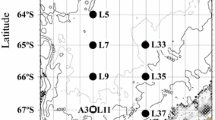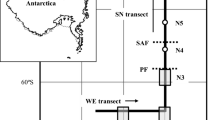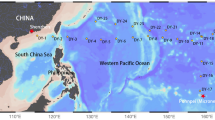Abstract
Microzooplankton was sampled during two cruises (Galápagos Vents, March 1985; Tongue of the Ocean and western edge of the Sargasso Sea, October/November 1985) by various collection methods (Niskin bottles, plankton nets, divers) to determine the vertical distribution and abundance of Acantharia. The larger size classes of Protozoa are dominated by the sarcodines, and Acantharia are frequently the most abundant of these in mesotrophic and oligotrophic oceans. The absolute densities of Acantharia have been consistently underestimated in many previous studies for two reasons: their skeletons dissolve in preserved samples, and they are undersampled by fine-meshed plankton nets. The previously identified dissolution problem may be less severe for concentrated samples because the dissolution of a portion of the Acantharia will raise the dissolved strontium concentration in the sample. Twenty five and 160 μm-mesh plankton nets consistently underestimate the abundance of net plankton by one to two orders of magnitude. Possible reasons for this significant error are discussed. In the Equatorial Pacific Ocean, Acantharia were found at densities as high as 30 liter-1 and integrated abundances of 1.58 to 5.34x105 Acantharia m-2. Up to 90% were concentrated near the surface; their abundance declined sharply below 20 m. At two stations in the Atlantic, peak densities reached 6.4 liter-1. Wind-mixing may spread individuals more evenly through the euphotic zone, but they reestablish their surface maximum during period of calm. Acantharia generally have relatively few, but large symbionts. Small individuals average about 6 symbionts per host, larger hosts average 40 symbionts, and some individuals may have thousands of algal cells. Acantharia symbionts made up less than 1% of the chlorophyll in the water column, even at their host's peak abundances of 30 liter-1. However, production estimates, using published sarcodine-symbiont production-rates, suggest that Acantharia could occasionally account for up to 20% or more of the carbon fixation in the upper euphotic zone of oligotrophic oceans.
Similar content being viewed by others
Literature cited
Anderson, O. R. (1983). Radiolaria. Springer-Verlag, New York
Anderson, O. R., Swanberg, N. R., Bennett, P. (1983). Assimilation of symbiont-derived photosynthates in some solitary and colonial radiolaria. Mar. Biol. 77: 265–269
Bé, A. W. H., Bishop, J. K. B., Sverdlove, M. S., Gardner, W. D. (1985). Standing stock, vertical distribution and flux of planktonic foraminifera in the Panama Basin. Mar. Micropaleont. 9: 307–333
Beers, J. R., Reid, M. H., Stewart, G. L. (1975). Microplankton of the North Pacific Gyre. Population structure and abundance, June 1973. Int. Revue ges. Hydrobiol. 60: 607–638
Beers, J. R., Stewart, G. L. (1969). Micro-zooplankton and its abundance relative to the larger zooplankton and other seston components. Mar. Biol. 4: 182–189
Beers, J. R., Stewart, G. L. (1970). The preservation of acantharians in fixed plankton samples. Limnol. Oceanogr. 15: 825–827
Beers, J. R., Stewart, G. L. (1971). Micro-zooplankters in the plankton communities of the upper waters of the eastern tropical Pacific. Deep-Sea Res. 18: 861–883
Bishop, J. K. B., Collier, R. W., Ketten, D. R., Edmond, J. M. (1980). The chemistry, biology and vertical flux of particulate matter from the upper 1500m of the Panama Basin. Deep-Sea Res. 27: 615–640
Bishop, J. K. B., Edmond, J. M. (1976). A new large volume filtration system for the sampling of oceanic particulate matter. J. mar. Res. 34: 181–198
Bishop, J. K. B., Edmond, J. M., Ketten, D. R., Bacon, M. P., Silker, W. B. (1977). The chemistry, biology and vertical flux of particulate matter from the upper 400 m of the equatorial Atlantic Ocean. Deep-Sea Res. 24: 511–548
Bishop, J. K. B., Ketten, D. R., Edmond, J. M. (1978). The chemistry, biology and vertical flux of particulate matter from the upper 400 m of the Cape Basin in the southeast Atlantic Ocean. Deep-Sea Res. 25: 1121–1161
Brass, G. W., Turekian, K. K. (1974). Strontium distribution in GEOSECS oceanic profiles. Earth planet. Sci. Lett. 23: 141–148
Cachon, J., Cachon, M. (1985). Actinopoda. In: Lee, J. J., Hutner, S. H., Bovee, E. C. (eds.) An illustrated guide to the protozoa. Society of Protozoologists, Lawrence, Kansas, p. 274–283
Eppley, R. W., Renger, E. H., Venrick, E. L., Mullin, M. M. (1973). A study of plankton dynamics and nutrient cycling in the central gyre of the North Pacific Ocean. Limnol. Oceanogr. 18: 534–551
Febvre, J., Febvre-Chevalier, C. (1979). Ultrastructural study of zooxanthellae of three species of Acantharia (Protozoa: Actinopoda), with details of their taxonomic position in the Prymnesiales (Prymnesiophyceae, Hibberd, 1976). J. mar. Biol. Ass. U.K. 59: 215–226
Febvre, J., Febvre-Chevalier, C. (1982). Motility processes in Acantharia (Protozoa). I. Cinematographic and cytological study of the myonemes. Evidence for a helix-coil mechanism of the constituent filaments. Biol. cell. 44: 283–304
Fitzwater, S. E., Knauer, G. A., Martin, J. H. (1982). Metal contamination and its effects on primary production measurement. Limnol. Oceanogr. 27: 544–551
Gardner, W. D. (1977). Incomplete extraction of rapidly settling particles from water samplers. Limnol. Oceanogr. 22: 764–768
Graham, L. B., Colburn, A. D., Burke, J. C. (1976). A new simple method for gently collecting planktonic protozoa. Limnol. Oceanogr. 21: 336–340
Hayward, T. L., Venrick, E. L., McGowan, J. A. (1983). Environmental heterogeneity and planktonic community structure in the central North Pacific. J. mar. Res. 41: 711–729
Khmeleva, N. N. (1967). Role of radiolarians in the estimation of the primary productivity in the Red Sea and the Gulf of Aden. Dokl. (Proc.) Acad. Sci. U.S.S.R. 172: 1430–1433
Massera Bottazzi, E., Andreoli, M. G. (1974). Distribution of Acantharia in the North Atlantic. Archo Oceanogr. Limnol. 18: 115–145
Massera Bottazzi, E., Andreoli, M. G. (1982a). Distribution of the Acantharia in the Western Sargasso Sea in correspondence with “thermal fronts”. J. Protozool. 29: 162–169
Massera Bottazzi, E., Andreoli, M. G. (1982b). Distribution of adult and juvenile Acantharia (Protozoa Sarcodina) in the Atlantic Ocean. J. Plankton Res. 4: 757–777
Massera Bottazzi, E., Schreiber, B., Bowen, V. T. (1971). Acantharia in the Atlantic Ocean, their abundance and preservation. Limnol. Oceanogr. 16: 677–684
Massera Bottazzi, E., Vannucci, A. (1964). Acantharia in the Atlantic Ocean. A systemic and ecological analysis of plankton collections made during cruises Chain 17 and Chain 21 of the Woods Hole Oceanographic Institution. 1st Contribution. Archo Oceanogr. Limnol. 13: 315–385
Massera Bottazzi, E., Vannucci, A. (1965a). Acantharia in the Atlantic Ocean. A systematic and ecological analysis of plankton collections made during cruise 25 of R.V. Chain, of the Woods Hole Oceanographic Institution. 2nd Contribution. Archo Oceanogr. Limnol. 14: 1–68
Massera Bottazzi, E., Vannucci, A. (1965b). Acantharia in the Atlantic Ocean. A systematic and ecological analysis of plankton collections made during cruise 89 of R.V. Crawford of the Woods Hole Oceanographic Institution. 3rd Contribution. Archo Oceanogr. Limnol. 14: 154–257
Massera Bottazzi, E., Vijayakrishnan Nair, K., Balani, M. C. (1967). On the occurrence of Acantharia in the Arabian Sea. Archo Oceanogr. Limnol. 15: 63–67
Michaels, A. F. (1986). Symbiotic primary production in Acantharia: alternative pathways of carbon flow through ocean ecosystems. EOS Trans., Am. geophys. Un. 67: p. 980
Pace, M. L. (1986). An empirical analysis of zooplankton community structure across lake trophic gradients. Limnol. Oceanogr. 31: 45–55
Parsons, T. R., Maita, Y., Lalli, C. M. (1984). A manual of chemical and biological methods for seawater analysis. Pergamon Press, Oxford
Rivkin, R. B., Lessard, E. J. (1986). Photoadaptation and photosynthetic carbon uptake by solitary Radiolaria: comparisons with free-living phytoplankton. Deep-Sea Res. 33: 1025–1038
Schewiakoff, W. (1926). Die Acantharia. Fauna & Flora Golfo Napoli 37: 1–755 (Atlas: 46 Plates, 22 Tables)
Silver, M. W., Davoll, P. J. (1978). Loss of 14C activity after chemical fixation of phytoplankton: error source for autoradiography and other productivity measurements. Limnol. Oceanogr. 23: 362–368
Spero, H. J., Parker, S. L. (1985). Photosynthesis in the symbiotic planktonic foraminifer Orbulina universa and its potential contribution to oceanic primary productivity. J. foraml Res. 15: 273–281
Swanberg, N. R. (1983). The trophic role of colonial Radiolaria in oligotrophic oceanic environments. Limnol. Oceanogr. 28: 655–666
Swanberg, N. R., Harbison, G. R. (1980). The ecology of Collozoum longiforme, sp. nov., a new colonial radiolarian from the equatorial Atlantic Ocean. Deep-Sea Res. 27A: 715–732
Takahashi, K. (1983). Radiolaria: sinking population, standing stock, and production rate. Mar. Micropaleont. 8: 171–181
Taylor, F. J. R. (1982). Symbiosis in marine microplankton. Annls Inst. océanogr., Paris (N.S.) 58 (Suppl): 61–90
Venrick, E. L. (1979). The lateral extent and characteristics of the North Pacific Central environment at 35 N. Deep-Sea Res. 26A: 1153–1178
Author information
Authors and Affiliations
Additional information
Communicated by P. C. Schroeder, Pullman
Rights and permissions
About this article
Cite this article
Michaels, A.F. Vertical distribution and abundance of Acantharia and their symbionts. Marine Biology 97, 559–569 (1988). https://doi.org/10.1007/BF00391052
Accepted:
Issue Date:
DOI: https://doi.org/10.1007/BF00391052




